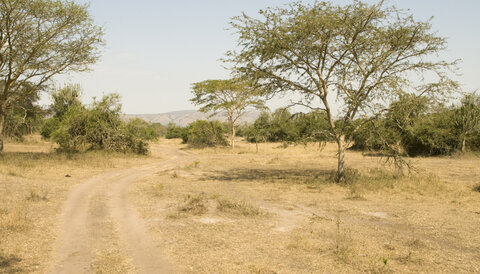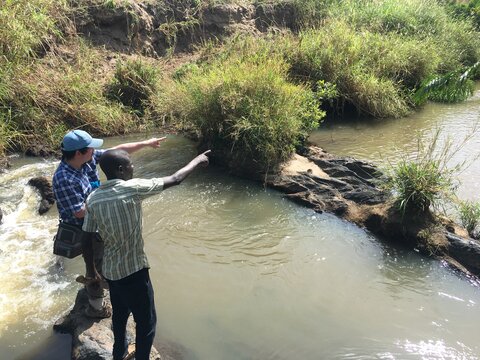Where is the best site for a trap?

When deciding where to place a tsetse trap consider:
- Suitable habitat
- Host-seeking behaviour
Tsetse habitat
Tsetse like to have some shade and places to rest, so will be found in areas with more vegetation available.
- For savanna tsetse, look for areas of woodland or thicket and avoid open areas such as fields and open grasslands (vleis, dambos)
- For riverine tsetse, look for an area along the river bank, again with woodland or other vegetation and avoiding open fields.
If you have a large area to survey, satellite imagery and data can help to select potential areas to sample.

Tsetse behaviour
Tsetse flies use their sight to locate their food. The blue and black of tsetse traps are attractive to tsetse, mimicking animal prey. When placing a trap, you therefore need a site where it will be clearly visible to the flies.
- Select an open site, ideally with paths or linear openings leading to the site that make the trap clearly visible from a distance.
- For riverine tsetse, the river itself may act as a path for the flies. Pay attention to the surrounding vegetation.
- Avoid obstructions, such as termite hills or dense leafy bushes within 3 metres of the trap.
- There should also be no fallen tree boles within 15 metres of the trap. They may distract from the trap as alternative dark oblongs.
It is also important to have light above the tsetse trap, it entices the tsetse to move upwards and into the cage from the blue-black fabric beneath. Therefore:
- No leafy canopy overhead, especially if this might shade the trap when tsetse are active in the early morning or late afternoon.
See also: How do tsetse find their hosts?
References
Laveissiere, C & Couret, D. (1980). Traps impregnated with insecticide for the control of riverine tsetse flies. Transactions of the Royal Society of Tropical Medicine and Hygiene 74, 264-265.
Mwangelwa, M.I., Dransfield, R.D., Otieno, L.H., Mbata, K.J. (1990). Distribution and diel activity patterns of Glossina fuscipes fuscipes Newstead on Rusinga island and mainland in Mbita, Kenya. Insect Science and Its Application 11, 315-321.
Mohamed-Ahmed, M.M. & Wynolds, Y. (1997). Effects of vegetation and weather on trap catches of Glossina fuscipes fuscipes near Lake Victoria, Kenya. Entomologia Experimentalis et Applicata 85, 231-236.
Vale, G.A. (1999). Responses of tsetse flies (Diptera: Glossinidae) to vegetation inZimbabwe: implications for population distribution and bait siting. Bulletin of Entomological Research 88, Supplement 1, S7-S59.